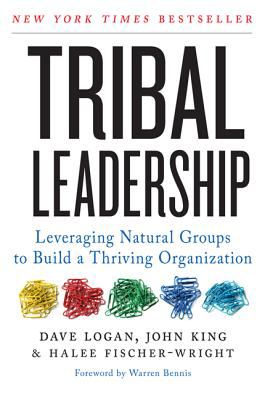Tribal Leadership: Leveraging Natural Groups to Build a Thriving Organization
by Dave Logan and John King (2008)
ISBN: 978-0-06-125130-6
–Review by Douglas Balzer
We have all heard that we are “the average of the five people we spend the most time with” or “a product of our environment.” While these may have some validity, Tribal Leadership: Leveraging Natural Groups to Build a Thriving Organization focuses on the reverse idea: a change of an individual also affects their environment.
The climate of a church/company is also known as organizational culture. According to author Dave Logan, culture is the most crucial determinant of a church’s/business’s success. Every church/company consists of tribes, which are the most basic social units in which humans evolved to function.
Tribes function in one of the five stages of tribal society. Stages one and two are hostile and apathetic and are not very efficient. Stage three appears when individuals begin to care for improvement on a personal level. Stage four is optimal for churches, thanks to the habit of collaboration that arises. In the stage, five, people abandon the idea of competition and instead focus on the joint mission that drives their purpose.
No matter if you are already a leader or only beginning to dream about being one, this book
is going to be a revelation. Let us see how to level up the tribal game!
Here are three lessons I learned about tribal development and how to enhance it:
A tribe is a social structure that humans evolved to operate within.
No matter how prehistoric the word “tribe” may sound to you, it is still the underlying social structure today. This is just how humans are wired. We need others not only to survive but also, to learn, thrive emotionally, and pursue projects that would be impossible to complete alone.
In the book Sapiens, Y. N. Harari argues that an average person can support personal connections with up to 150 acquaintances. This is how big a tribe can get before it starts splitting into groups. Usually, a tribe consists of somewhere between 20 and 150 people. This was true for our ancestors 40,000 years ago and has not changed much since.
You are a part of several tribes throughout your life. Some of these groups include your family, school, local fishing club, and workplace.
Where you work is a perfect example, because it illustrates the primary purpose for a tribe’s existence: working individually on different tasks, while contributing to a common goal. This ensures that everybody plays a part and has a chance to build something bigger than themselves.
A tribe fulfills its purpose most effectively when progression reaches stage four or five. But
how do you define those stages?
The way people relate to each other determines the stage of tribal improvement.
Within a church/company, a tribe is typically more significant than a team but smaller than the organization. All members of the tribe know of each other’s existence, but the degree to which they interact varies.
The interactions and relationships between individuals determine the overall culture. We cannot overestimate the importance of human connections, and this is not just Logan’s theory, either. In his best-selling book Tribes, Seth Godin also argues that essential links between people are the most significant advantage the group can ever have.
So, what kind of connections do we mean here? First, they need to stem from the sense of security everyone has about their position. People must feel safe enough to put collaboration over competition. This personal sense of safety is what the leader needs to foster at stage three.
When people feel safe, tribal interactions begin to focus on collective goals and unite
around shared values. At this point, people start forming groups of three instead of two, or
triadic relationships rather than dyadic. Triadic relationships help collective growth. In
the words of Logan:
“Triads lead to a blurring of roles between client, service provider, friend, mentor, and coach. Once the triad is established, all the roles merge and morph, requiring each person to contribute to, and receive contributions from, the other two.”
Once the leader knows what kind of relationships support the tribe’s growth, all she needs to do is use this knowledge in practice. The question is, how?
To bring your tribe’s progress to the next level, focus on individuals.
Upgrading the atmosphere of a group is the leader’s primary responsibility. It is no easy task since the current stage of development dictates how the members behave. Therefore, to level up the group, the leader needs to work with individuals first.
A famous example of how to do this is the case of the Griffin Hospital in Derby, Connecticut. Employees there used to struggle with many problems, tribal culture included. The CEO and vice president of the hospital solved most issues by engaging with the staff individually. He asked for their opinions on important matters like patient treatment and new building designs.
Consequently, team members felt valued by their leaders. It, in turn, empowered them to shift the focus from their insecurities to supplying better quality treatment to patients. By offering their attention to individual staff members, the management succeeded in upgrading the culture from stage two to three, and then four.
Therefore, the final guideline for leaders is that tribes can only move forward one stage at a time. Do not try to rush it and jump, say, from stage two straight to stage four. The collective growth must be incremental and sustained to be authentic and lasting.
The people you associate with certainly affect you. But the bold and empowering statement that Tribal Leadership makes is that you can influence your environment, too! This refreshing read will be helpful not only to formally designated leaders but also to anyone who cares about making a difference in their world.

